Published: march 21, 2010; Intelligence and Terrorism Information Center.
Turning Shaheeds into Role Models: Fatah unofficially inaugurated the Dalal al-Magribi Square in Al-Bireh, named after a Fatah terrorist who participated in the mass-murder attack on Israel’s Coastal Road (1978).
Three months ago the Palestinian Authority announced that on March 11, 2010, an official ceremony would be held in the town of Al-Bireh (in the vicinity Ramallah) to inaugurate the Dalal al-Magribi Square. The square was erected to honor al-Magribi, a female Palestinian terrorist who participated in the March 1978 mass-murder attack on Israel’s Coastal Road. Since the mass-murder attack, in which 37 Israelis were murdered and 71 wounded, Dalal al-Magribi has become a kind of national heroine, whose action was lauded by Yasser Arafat and who has been commemorated and praised by the Palestinian Authority.
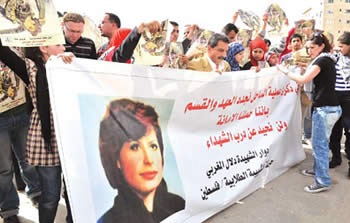
Inaugurating Dalal al-Magribi Square in Al-Bireh, March 11, 2010. Holding the center of the banner is senior Fatah figure Tawfiq Tirawi (Al-Quds TV, March 12, 2010)
Shortly before the ceremony was scheduled to take place the Palestinian Authority announced it would be cancelled for “technical reasons.” According to the Al-Bireh municipality, the reason was Israeli pressure on the Palestinian Authority (Reuters, March 10, 2010). Palestinian spokesmen, on the other hand, were quick to proclaim that no power in the world could prevent them from feeling pride in their history.
Despite the cancellation, which in our assessment was the result of the Palestinians’ desire to placate the Americans in light of Vice President Biden’s visit, the ceremony was held on the appointed day, but unofficially. On March 11 dozens of Palestinian youths came to the square to participate. Senior Fatah figures were in attendance, notably Tawfiq Tirawi, a member of Fatah’s Central Committee, Mustafa Abu Rabbi’a, a senior Fatah figure in Ramallah, and Jamal Hawil, a member of the Fatah faction in the Palestinian Legislative Council. A large picture of the terrorist was set up in the square.
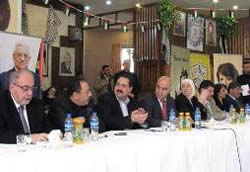
Birthday celebration for Dalal al-Magribi held by Fatah’s National Political Guidance Committee (Wafa News Agency, January 16, 2010)
The official Palestinian media covered the event and devoted a number of programs and newspaper columns to it, emphasizing the Dalal al-Magribi’s importance and action:
A. On March 11, the official Palestinian TV station broadcast a memorial program to honor her legacy. Her sister Rashida (who is currently an officer in the Palestinian Authority security forces) appeared on the program. She said “Today is a day of pride and victory for the Palestinian people and a day of pain for the Zionists,” and asked the viewing audience to gather in the square (MEMRI, March 17, 2010).B. Writing for Al-Hayat Al-Jadeeda, ‘Adel Abd al-Rahman wondered why Israel was allowed to commemorate its people while not permitting the Palestinian Authority to do the same (Al-Hayat Al-Jadeeda, March 14, 2010).C. Al-Ayam published a number of articles and columns about al-Magribi. An article written by Muhammad Abd al-Hamid represented her as a “freedom fighter.” A column written byRaja Rantisi claimed that if she were to return today she would no doubt be pleased by what she saw (Al-Ayam, March 14, 2010).
At the same time, the de facto Hamas administration announced it would name two main squares in Gaza City for female shaheeds. One would be dedicated to Dalal Magribi and the other to Rim al-Riyashi, a Hamas suicide bomber, who on January 14, 2004, blew herself up at the workers’ terminal at the Erez crossing. (The blast killed three Israeli soldiers and one civilian, and wounded ten others.) According to the announcement, the decision to rename the squares was the result of the Hamas administration’s faith “in the honorable history of the resistance [i.e., terrorist organizations] and its factions,” and in defiance of Mahmoud Abbas, who cancelled the ceremony in Al-Bireh following pressure from Israel (Hamas’ Palestine-info website, March 18, 2010).
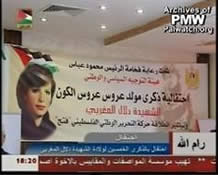
Banner for terrorist Dalal al-Magribi’s 50th birthday celebration, held under the auspices of Mahmoud Abbas (Photo courtesy of Palestinian Media Watch)
Making Dalal al-Magribi a Role Model
Dalal al-Magribi became a kind of “national heroine” for the Palestinian public during the era of Yasser Arafat, who praised and glorified her. The Palestinian Authority has immortalized her by naming schools (such as a girls’ school in Hebron), computer centers, summer camps and sporting events after her. In the Gaza Strip a play was written and produced about her, and a street and soccer team were named after her.
Such activities are part of Hamas and Palestinian Authority policy to find various ways to commemorate leaders and operatives who participated in the struggle against Israel, even if they were the heads of terrorist organizations or operatives involved in mass-murder attacks which claimed the lives of Israeli civilians. The legacy, fostered by the Palestinians, not only turns terrorist operatives into role models for the younger generation (and the rest of the population), but it legitimizes past, present and future terrorist attacks against Israel. However, while Hamas in the Gaza Strip is engaged in intense incitement against Israel, in recent years the Palestinian Authority has limited prominent expressions of extreme incitement, but does nothing to check and sometimes encourages the shaheed cult.
For example:
A. In December 2009, under the auspices of Mahmoud Abbas, Fatah’s National Political Guidance Committee held a celebration to mark Dalal al-Magribi’s 50th birthday. It was attended by senior Fatah and Palestinian Authority figures, whose speeches praised her as a symbol of the struggle. There was also a parade of children who marched in her honor. A huge banner was hung at the celebration, bearing her picture and the inscription, “Under the auspices of his honor the president, Mahmoud Abbas” (Wafa News Agency, December 29, 2009). In addition, Mahmoud Abbas gave a speech at a meeting of the Palestinian Legislative Council on January 16, 2010, in which he noted that the Palestinian Authority was behind the decision to build a square commemorating al-Magribi (Wafa News Agency, January 17, 2010).B. On January 20, 2010, an exhibition opened at the Friends Girls School in Ramallah, devoted to the “shaheeds of the Palestinian revolution and national movement.” It featured pictures of Sheikh Ahmed Yassin (Hamas founder and leader), Dr. Fathi Shqaqi(Palestinian Islamic Jihad leader), Abu Ali Mustafa (secretary-general of the Popular Front for the Liberation of Palestine), Abu Jihad (a senior Fatah leader) and Dalal al-Magribi. The opening ceremony was attended by Ms. Majida al-Masri, Palestinian minister of welfare, andIssa Qaraqe, Palestinian minister of prisoner affairs. Ms. al-Masri praised the students for their efforts to commemorate the shaheeds of the Palestinian national movement and told them stories about her personal relations with shaheeds.C. It has recently been reported that Issa Qaraqe,1 minister of prisoner affairs, initiated a move to name streets after Palestinian prisoners indicted by Israel for murder and serving terms of more than 20 years. The Palestinian government does not support the move, which aroused the opposition of a number of Judea and Samaria mayors, some of whom stated they had no intention of changing the names of the streets in their cities.
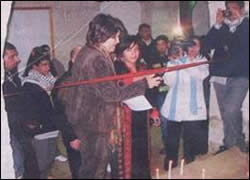
Palestinian Authority minister of welfare Ms. Majida al-Masri cuts the ribbon at the opening of the shaheed picture exhibition in Ramallah (Al-Ayam, February 20, 2010)
Appendix: The Mass-Murder Attack on the Israeli Coastal Road.
A Fatah terrorist squad attacked a bus on the Coastal Road on Saturday, March 11, 1978. In the morning an 11-man squad in inflatable rubber dinghies landed on the beach at Maagan Michael, about 30 kilometers, or 18 miles, south of Haifa. They happened upon Gail Rubin, an American nature photographer who was taking pictures at the time, and murdered her. They then continued eastward toward the Coastal Road, where two of them stopped a taxi and rode in the direction of Tel Aviv. The other terrorists stopped a bus carrying Israeli tourists on its way to Haifa, forced their way in and ordered the driver to turn the bus around and drive to Tel Aviv. During the ride they shot at cars passing by, killing four people.
Near the Israeli coastal city of Hadera, about 20 kilometers, or 12 miles, to the south, they were joined by the terrorists in the taxi, who forced all the taxi passengers onto the bus, which continued driving south. On the way they stopped another bus and also forced its passengers onto the same bus with them. Police forces did not succeed in stopping the bus, but just north of the entrance to Tel Aviv they shot out the bus’ tires and it stopped. A firefight developed with the terrorists, which ended when the terrorists blew up the bus, killing many of the passengers, 13 of them children.
Thirty-seven people were killed and 71 were wounded. In response Israel initiated Operation Litani in south Lebanon, where most of the military-terrorist infrastructure was based.
The image of Dalal al-Magribi, one of the terrorists, has been fostered as a “national heroine” of the Palestinian people. The Palestinians hoped her body would be turned over to them as part of the exchange on July 16, 2008, for the bodies of Eldad Regev and Ehud Goldwasser. DNA tests later showed that her remains were not among those of the Palestinian terrorists transferred to Hezbollah.
Notes:
1 Issa Qaraqe regularly writes a column about prisoner affairs for the Ma’an News Agency. It is full of hatred for Israel and demonizes Israel’s treatment of prisoners. For example, on February 14, 2010, it accused Israeli doctors of systematically and deliberately killing Palestinian prisoners.
Published: april 12, 2010; Intelligence and Terrorism Information Center.
You can read part 1 here, “Turning Shaheeds Into Role Models.”
The Palestinian Authority still allows and even encourages shaheeds to be turned into role models: in Ramallah a street is named after Yahya Ayash, the Hamas operative called “The Engineer.” He was behind suicide bombing attacks which killed several dozen Israeli civilians and were intended to sabotage the Oslo accords.

Sign for Yahya Ayash street, where the Palestinian Authority presidential compound in Ramallah is under construction (Picture courtesy of Israel Channel 10 TV, April 7, 2010)
A street in Ramallah is named for Yahya Ayash, one of the founders and heads of the Izz al-Din al-Qassam Brigades, Hamas’ military-terrorist wing. He was responsible for suicide bombing attacks between 1994-1996, which killed dozens of Israeli civilians and wounded hundreds. The Palestinian Authority presidential compound is currently being built on the street.

The Palestinian Authority presidential compound under construction on Yahya Ayash street (Picture courtesy of Israel Channel 10 TV, April 7, 2010)
The text gives information about Yahya Ayash: “Yahya Ayash, 1966-1996, born in Rafat [near Nablus], studied electrical engineering at Bir Zeit University. Was an Izz al-Din al-Qassam Brigades operative and Israel claimed he was responsible for a series of attacks. Israel killed him in Beit Lahiya [northern Gaza Strip], January 5, 1996” (Israel Channel 10 TV, April 7, 2010).
There is also a Yahya Ayash street in Jenin which was recently renovated by the Jenin municipality (PNN website, January 28, 2010).
Reactions
Israel:
The Israeli Prime Minister’s office issued a statement denouncing the event. Calling a street after Yahya Ayash, it said, “…is an outrageous glorification of terrorism by the Palestinian Authority… The world must forcefully condemn this official Palestinian incitement for terrorism and against peace”1 (Israeli Prime Minister’s Office website, April 8, 2010).
The United States:
A spokesman for the American Sate Department said “We…strongly condemn the glorification of terrorists. Honoring terrorists who have murdered innocent civilians, either by official statements or by the dedication of public places, hurts peace efforts and must end. We will continue to hold Palestinian leaders accountable for incitement”2 (United States State Department website, April 8, 2010).
The Palestinian Authority:
“Palestinian Authority sources” said the PA did not intend to name a street in Ramallah after Yahya Ayash. They denied the news items referring to the issue but added that the PA did not need authorization from Israel to name a street after a Palestinian shaheed (Al-Quds website, April 8, 2010). The Ramallah municipality said that a “professional panel” had decided the name of the street at the end of the 1990s, shortly after Yahya Ayash’s death (Safa News Agency, April 8, 2010).
Implications
The perpetuation of Yahya Ayash’s memory is another example of the ongoing policy of certain elements in the Palestinian Authority to foster the images of Palestinian terrorist operatives (“shadeeds”), who were killed during terrorist attacks against Israel. It turns them into symbols and role models (even if they were involved in terrorist attacks which killed Israeli civilians). That is part of preserving the belligerent legacy of the struggle against Israel and of constructing the national identity of the future Palestinian state.
One manifestation of that policy was the recent opening of a square in the Umm al-Sharait quarter in Al-Bireh, named after Fatah terrorist Dalal al-Mugribi. She belonged to the terrorist squad which attacked an Israeli bus on the Coastal Road in March 1978, killing 37 Israeli civilians and wounding 71. Since the attack she has become a national heroine. Her deeds were widely praised by Yasser Arafat at the time, and her memory has been perpetuated by the Palestinian Authority. The PA (unofficially)3 allowed Fatah to name the square after her, although during his visit to the Middle East (March 10, 2010), American Vice President Joe Biden asked Mahmoud Abbas not to do so.
Perpetuating the name of Yahya Ayash (“The Engineer”) in Ramallah is particularly glaring, because he was a senior operative in Hamas’ military-terrorist wing, the Izz al-Din al-Qassam Brigades, and did not belong to Fatah. He was behind a wave of suicide bombing attacks which were initiated by Hamas and meant to sabotage the Oslo accords (See Appendix). Thus in effect, even if it is not official Palestinian Authority policy, it helps preserve the legacy of terrorism, including suicide bombing terrorism.
Appendix: Yahya Ayash, “The Engineer”
The cover of the Filastin al-Muslima issue on the tenth anniversary of Yahya Ayash’s death (January 2006). His picture appears on the background of an Israeli bus, blown up by a suicide bomber. The inscription at the left reads “Yahya Ayash, the engineer of the modern resistance.”
Biography – Yahya Ayash was born on March 6, 1966, in the village of Rafat near Nablus. He got a degree in electrical engineering from Bir Zeit University in 1988.
Affiliation – Initially he belonged to the Muslim Brotherhood. During his studies at the university he was an activist in the Islamic Block (the Hamas student organization). At the beginning of the 1990s he was one of the founders of the Izz al-Din al-Qassam Brigades, Hamas’ military-terrorist wing, and became one of its leaders. He specialized in assembling explosive devices, especially for suicide bombers.
Involvement in terrorist attacks – In 1992 he began planning suicide bombing attacks in Israel. Until his death he was the head planner of most of Hamas’ suicide bombing attacks. In many instances he both prepared the explosive belts and strapped them to the suicide bombers’ bodies. In some cases he drove the bombers to their targets. He was personally responsible for the deaths of dozens of Israeli civilians and for the wounding of hundreds. Between 1994 and 1996 he was responsible for many attacks whose objective was to sabotage the Oslo accords. Conspicuous among the attacks were the suicide bombing attack on a number 5 urban bus in Tel Aviv (October 19, 1994, 20 dead), the attack in the central bus station in Hadera (April 13, 1994, 5 dead), the attack on the number 26 urban bus in Jerusalem (August 21, 1995, 4 dead), the attack in the Dizengoff Center mall in Tel Aviv (March 4, 1996, 13 dead), and others.
His involvement in suicide bombing attacks put him on the Israeli security forces’ wanted list. In 1994 he moved to the Gaza Strip, and on January 5, 1996, he was killed in Beit Lahiya in the northern Gaza Strip when a cellular phone he was holding blew up.
After his death he became a symbol for Hamas supporters and has repeatedly been commemorated in various forms in order to turn him into a role model for Palestinian youth.
An article by Samir Atiya entitled “Yahya Ayash, shaheed: words fail in view of the human sacrifice” (Filastin al-Muslima, a Hamas publication directed from Damascus and published in Britain, January 2004 issue). It calls for Yahya Ayash to be commemorated “artistically” through poems, literature, movies, television and audio tapes, to turn him into a mythic figure in the collective Palestinian memory. According to the article, “one of the most beloved and desired sons of the [Palestinian] people has gone… It was he [who created] a chain of suicide bombers…” It also calls for many other shaheeds to tread the same path, and mentions movies made about him, including one called “The Hawk of the Brigades.”
Perpetuating the memory of Yahya Ayash and the legacy of suicide bombing attacks: The Hamas-affiliated singing group Al-Aqsa Hawks in front of a picture of Yahya Ayash and a model of a bombed Israeli bus. The picture came from an article praising him and the suicide bombing attacks for which he was responsible (Filastin al-Muslima, January 2006).
Notes:
2 www.state.gov.
3 The official ceremony was canceled and instead Fatah held its own ceremony, attended by senior figures in the organization.


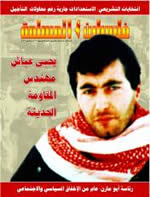


No comments:
Post a Comment